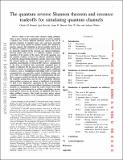| dc.contributor.author | Bennett, Charles H. | |
| dc.contributor.author | Devetak, Igor | |
| dc.contributor.author | Harrow, Aram W. | |
| dc.contributor.author | Shor, Peter W. | |
| dc.contributor.author | Winter, Andreas | |
| dc.date.accessioned | 2015-01-29T16:02:48Z | |
| dc.date.available | 2015-01-29T16:02:48Z | |
| dc.date.issued | 2014-03 | |
| dc.identifier.issn | 0018-9448 | |
| dc.identifier.issn | 1557-9654 | |
| dc.identifier.uri | http://hdl.handle.net/1721.1/93188 | |
| dc.description.abstract | Dual to the usual noisy channel coding problem, where a noisy (classical or quantum) channel is used to simulate a noiseless one, reverse Shannon theorems concern the use of noiseless channels to simulate noisy ones, and more generally the use of one noisy channel to simulate another. For channels of nonzero capacity, this simulation is always possible, but for it to be efficient, auxiliary resources of the proper kind and amount are generally required. In the classical case, shared randomness between sender and receiver is a sufficient auxiliary resource, regardless of the nature of the source, but in the quantum case, the requisite auxiliary resources for efficient simulation depend on both the channel being simulated, and the source from which the channel inputs are coming. For tensor power sources (the quantum generalization of classical memoryless sources), entanglement in the form of standard ebits (maximally entangled pairs of qubits) is sufficient, but for general sources, which may be arbitrarily correlated or entangled across channel inputs, additional resources, such as entanglement-embezzling states or backward communication, are generally needed. Combining existing and new results, we establish the amounts of communication and auxiliary resources needed in both the classical and quantum cases, the tradeoffs among them, and the loss of simulation efficiency when auxiliary resources are absent or insufficient. In particular, we find a new single-letter expression for the excess forward communication cost of coherent feedback simulations of quantum channels (i.e., simulations in which the sender retains what would escape into the environment in an ordinary simulation), on nontensor-power sources in the presence of unlimited ebits but no other auxiliary resource. Our results on tensor power sources establish a strong converse to the entanglement-assisted capacity theorem. | en_US |
| dc.language.iso | en_US | |
| dc.publisher | Institute of Electrical and Electronics Engineers (IEEE) | en_US |
| dc.relation.isversionof | http://dx.doi.org/10.1109/tit.2014.2309968 | en_US |
| dc.rights | Creative Commons Attribution-Noncommercial-Share Alike | en_US |
| dc.rights.uri | http://creativecommons.org/licenses/by-nc-sa/4.0/ | en_US |
| dc.source | arXiv | en_US |
| dc.title | The Quantum Reverse Shannon Theorem and Resource Tradeoffs for Simulating Quantum Channels | en_US |
| dc.type | Article | en_US |
| dc.identifier.citation | Bennett, Charles H., Igor Devetak, Aram W. Harrow, Peter W. Shor, and Andreas Winter. “The Quantum Reverse Shannon Theorem and Resource Tradeoffs for Simulating Quantum Channels.” IEEE Trans. Inform. Theory 60, no. 5 (May 2014): 2926–2959. | en_US |
| dc.contributor.department | Massachusetts Institute of Technology. Department of Mathematics | en_US |
| dc.contributor.department | Massachusetts Institute of Technology. Department of Physics | en_US |
| dc.contributor.mitauthor | Harrow, Aram W. | en_US |
| dc.contributor.mitauthor | Shor, Peter W. | en_US |
| dc.relation.journal | IEEE Transactions on Information Theory | en_US |
| dc.eprint.version | Author's final manuscript | en_US |
| dc.type.uri | http://purl.org/eprint/type/JournalArticle | en_US |
| eprint.status | http://purl.org/eprint/status/PeerReviewed | en_US |
| dspace.orderedauthors | Bennett, Charles H.; Devetak, Igor; Harrow, Aram W.; Shor, Peter W.; Winter, Andreas | en_US |
| dc.identifier.orcid | https://orcid.org/0000-0003-3220-7682 | |
| dc.identifier.orcid | https://orcid.org/0000-0003-4626-5648 | |
| mit.license | OPEN_ACCESS_POLICY | en_US |
| mit.metadata.status | Complete | |
